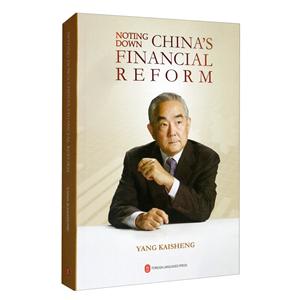-
>
营销管理
-
>
茶叶里的全球贸易史(精装)
-
>
近代华商股票市场制度与实践(1872—1937)
-
>
麦肯锡图表工作法
-
>
底层逻辑:看清这个世界的底牌
-
>
李诞脱口秀工作手册
-
>
成事:冯唐品读曾国藩嘉言钞
Noting down Chinas financial reform(中国金融改革的探索与实践——杨凯生金融笔记) 版权信息
- ISBN:9787119122915
- 条形码:9787119122915 ; 978-7-119-12291-5
- 装帧:一般胶版纸
- 册数:暂无
- 重量:暂无
- 所属分类:>
Noting down Chinas financial reform(中国金融改革的探索与实践——杨凯生金融笔记) 内容简介
Noting Down China's Financial Reform is a review and summary of the most important practices and major events in ttie reform and development of China's financial industry since the 1990's. A record of the process of China's firtaocial reform, it interpfets and ana;lyzes the reform principles and policies with a senior banker's insight ovef the past 20 years.
Noting down Chinas financial reform(中国金融改革的探索与实践——杨凯生金融笔记) 目录
Noting down Chinas financial reform(中国金融改革的探索与实践——杨凯生金融笔记) 节选
《中国金融改革的探索与实践:杨凯生金融笔记(英文)》: The asset recovery ratio notched up by the Chinese AMCs was no less than those of global models like the RTC and KAMCO.Notably, the high asset and cash recovery ratios were achieved against comparatively low asset quality. When the RTC acquired USD465 billion assets from nearly 1,000 S&Ls, only one-third of the assets were classifted as NPLs, and 92 percent of the NPLs had collaterals. In contrast, among the purchased assets of China's four AMCs, a large part of the bad debts (including de facto ones) were eligible for write-offs, yet remained on the banks' balance sheets due to all kinds of reasons, and the proportion stood at almost 40 percent. A closer feview of the collaterals showed that over 70 percent of the four AMCs' purchased assets belonged to credit loans, whereas the validity of the collaterals and guarantees of the remaining less than 30 pefcent of secured loans were still questionable. Given those scenarios, it was extremely tough for the AMCs to achieve such high recovery ratios, which should assure us of the promising future of China's fmancial AMCs. We must also un-derline the low operating cost. In 2000, the total financial expense of the four AMCs was around RMB1.48 billion, only 0.1 percent of the total distressed assets under their management, while the annual percentage of the RTC's financial expense on average was over 1 percent, a 1:10 ratio in comparable costs. In other words,the Chinese AMCs realized a higher return with less expense and effectively controlled the cost for handling legacy issues. 4. Promoting market-oriented resource allocation and econom-ic restructuring by mergers and acquisitions (M&As), asset reor-ganization, bankruptcy liquidation, etc. We firmly believe that dis-In the past two years, the four AMCs undertook distressed asset disposal with strong self-motivation to serve the bigger picture of economic restructuring. With a portfolio of measures such as asset sale, auction, call for bids, asset and debt restructuring, asset re-placement, and M&As, they restructUfed thousands of enterprises'on-balance-sheet assets worth tens of billions of renminbi. It even led to the reorganization of enterprises in different industries and regions and under different ownerships. For example, asset restructuring in building material and textile industries opumized their industrial organizations; the transfer of distressed assets to private capital and multinational corporations diversified the ownership structure of SOEs; the 300-odd M&As channeled useful resources to enterprises with competitive edge and enabled SOEs to grow bigger and stronger; through debt re-covery and bankruptcy liquidation, nearly 1,000 companies with poor management, irreversible losses, resource wastage or heavy pollution were phased out. The reforms in corporate governance also led to agreements on IPOs assistance, underwriting and spon-sorship with dozens of enterprises. In addition, the four AMCs helped more than 20 listed companies with their reorganization,which revitalized the companies, helped the securities market stay stable and safeguarded investors' interests.tressed assets should be viewed as a kind of misallocated resource. ……
Noting down Chinas financial reform(中国金融改革的探索与实践——杨凯生金融笔记) 作者简介
杨凯生,武汉大学经济学院毕业,博士,研究员。现任中国银行保险监督管理委员会靠前咨询委员会委员。北京大学经济学院兼职教授、中国政法大学兼职教授、中国人民银行金融研究所博士生导师、北京大学互联网金融研究中心特约不错研究员。杨凯生曾任中国华融资产管理公司总裁,中国工商银行副董事长、行长,工银瑞信资产管理公司董事长、南非标准银行副董事长。杨凯生是第十一届、十二届全国政协委员。
- >
朝闻道
朝闻道
¥8.8¥23.8 - >
月亮与六便士
月亮与六便士
¥15.1¥42.0 - >
伊索寓言-世界文学名著典藏-全译本
伊索寓言-世界文学名著典藏-全译本
¥9.3¥19.0 - >
推拿
推拿
¥12.2¥32.0 - >
我从未如此眷恋人间
我从未如此眷恋人间
¥24.4¥49.8 - >
二体千字文
二体千字文
¥22.4¥40.0 - >
苦雨斋序跋文-周作人自编集
苦雨斋序跋文-周作人自编集
¥5.8¥16.0 - >
回忆爱玛侬
回忆爱玛侬
¥23.0¥32.8
-
富爸爸穷爸爸
¥29.5¥89 -
就业、利息和货币通论
¥25.5¥50 -
萨缪尔森谈金融贸易与开放经济
¥10¥25 -
投资人和你想的不一样
¥20.5¥65 -
金融案鉴:金融领域违纪违法典型案例警示教育读本
¥28.4¥56 -
货币论-下卷
¥17.7¥32





















